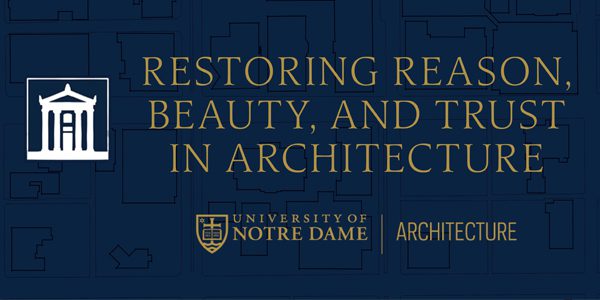Raphael’s School of Athens: The Medium and the Message – What Does it All Mean? The Painting and its Subject
Subscribe to the ThinkND podcast on Apple, Spotify, or Google.
Featured Speakers:
- David Mayernik, Associate Professor, School of Architecture, University of Notre Dame
In Week 1 of the Rome Bookclub series on Raphael’s School of Athens, Professor David Mayernick, Associate Professor in the School of Architecture was joined by Professor Ingrid Rowland. The professors introduced the listeners to Raphael as a person, an artist, and a thinker. They answered the questions: What did he know, and when did he know it? How did he grow as an artist outside the usual studio system? Was he an intellectual as well as an artist?
Rowland started the conversation by speaking about two individuals that Raphael was likely influenced by. The first individual was Egidio da Viterbo, a popular preacher. Rowland said, “[Rafaello’s] lucky to be in the company of two of the greatest explainers of his era- one of them is named Egidio da Viterbo[…] he was famous as a preacher and what he did was try to bring the ideas of Plato into play with normal people. He’s probably in situations where he can talk to Raphael one-on-one. So some of what rafael is getting is from this man who was really the most influential theologian of his day and the most popular preacher.” The second man was Tommaso Inghirami, “ the greatest actor of renaissance Rome”. Rowland remarked that “Raphael could ask him about things and [he wasn’t going to get] just some boring disquisition”. Rowland and Mayernick agreed that it is most likely that these two individuals were incredible sources of knowledge for Raphael. Mayernick then posed the question “how much did raphael bring to the conversation? Was he just the receptor or did he have anything to offer? we don’t really know. but when somebody paints something as influential and successful and sophisticated as what he painted, i think he’s more than just a brush, he has to bring something- it’s not his capacity to dig deep into those things, but to synthesize. He makes things easily understood by others”. Rowland replied that while Raphael most likely was very intellectual himself, he was also probably a very good listener and receptor of information. She went on to say that “I think one of the reasons people thought he was so charming was that he was a good listener. You never really hear about what he was like, you hear that he was gentile and charming and with the giant egos of the renaissance i suspect that meant that he just sat quietly and just took it all in and processed it”. In closing, Mayernick drew a parallel between Raphael’s ability to listen and the figures he depicted as listeners in his paintings, saying “painting is a silent medium. Whatever it can express, it has to express in silence. The challenge for the artist is whether you represent things happening or human interactions that involve speaking and listening. So as much as there is talking going on in the School of Athens, it means that more than half are listening. It puts the viewer of the painting as ‘listeners’. when he’s painting someone who is listening, he is painting you, the viewer, in that place.”
- The great quality we see in renaissance art is partly due to the systematic exploitation of child labor (14:48 Rowland)
- (Rowland 17:00- 20:30) he’s lucky to be in the company of two of the greatest explainers of his era- one of them is named Egidio da Viterbo[…] he was famous as a preacher and what he did was try to bring the ideas of Plato into play with normal people. He’s probably in situations where he can talk to Raphael one-on-one. So some of what rafael is getting is from this man who was really the most influential theologian of his day and the most popular preacher.
- (Rowland 21:00 – 25:00) the other man who is in constant contact with Raphael while he’s painting the school of Athens is Tommaso Inghirami, who is the greatest actor of renaissance rome. […] so raphael could ask him about things and he’s not just going to get some boring disquisition.
- i think that’s where he’s getting a lot of his information from, these two spectacularly dramatic performers (Rowland 26:00)
- The question is how much did raphael bring to the conversation? was he just the receptor or did he have anything to offer? we don’t really know. but when somebody paints something as influential and successful and sophisticated as what he painted, i think he’s more than just a brush, he has to bring something- it’s not his capacity to dig deep into those things, but to synthesize. He makes things easily understood by others. (Mayernick 26:00)
- The school of Athens isn’t filled with blank slates of figures, they’re really people. so he has their same ability to bring things to life (Rowland 27:00)
- florence is an absolutely crucial stop in raphael’s development and in the development of the whole artistic sensibilty (Rowland 31:00)
- I think one of the reasons people thought he was so charming was that he was a good listener. you never really hear about what he was like, you hear that he was gentile and charming and with the giant egos of the renaissance i suspect that meant that he just sat quietly and just took it all in and processed it. (Rowland 32:00)
- what there was between michelangelo and raphael was competition. and raphael being the younger one, probably thinks he has more to learn (Rowland 36:45)
- (Rowland) 44:00 – i think raphael has this way of conveying peace and belonging that is universal
- (Mayernick) 45:00 46:00 – painting is a silent medium. Whatever it can express, it has to express in silence. The challenge for the artist is whether you represent things happening or human interactions that involve speaking and listening. so as much as there is talking going on in the school of Athens, it means that more than half are listening. it puts the viewer of the painting as “listeners”. when he’s painting someone who is listening, he is painting you, the viewer, in that place.
Related Content
How Cities Speak To Us
Professor Emily Talen joins the School of Architecture to share her work at The Urbanism Lab and its focal point at the University of Chicago for the study of the built...
View EventThe Black National Anthem & Parent’s Signing Off On Children Reading Black Books
In this week’s episode, Isaiah and Tykiera talk about some tweets about Black people that took Twitter by storm. They also talk about The Black National Anthem, Lift Every Voice...
watch videoTrusted AI Needs Trusted Data
In the buzz around AI, let’s not ignore the role of data for developing AI we can trust, says one Notre Dame computational scientist. Two years ago, Notre Dame launched the...
Read Article


